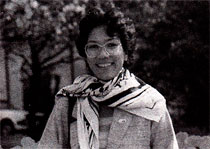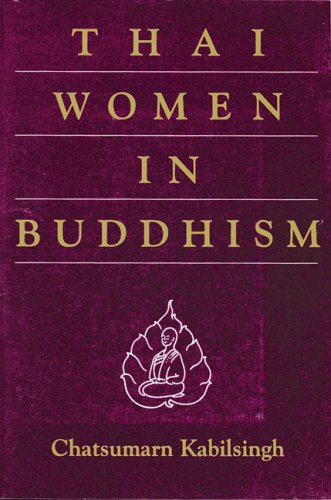Thai Women in Buddhism
By Chatsumarn Kabilsingh.
Parallax Press: Berkeley, 1991.
110 pp. $12.00 (paperback)
Chatsumarn Kabilsingh, professor of Religion and Philosophy at Thammasat University in Bangkok, has written a book as skillful as a surgeon’s knife, and with the healing potential of ancient herbalist lore. In this case, the troubled body is nothing less than Thai society from the time of Buddha until now, and in particular its discrimination against women. In point of fact, her calm and succinct analysis of a culture’s systematic repression and denigration of women, reinforced by a patriarchal interpretation of religious teachings, could apply to most cultures. Written without rancor, her work seeks to redress an entrenched imbalance of power between the sexes and a biased interpretation of the worth and role of women—two factors that have caused untold psychic and material suffering for women.

Beginning with an overview of Buddhism in Thai history and perspectives on Thai women, Kabilsingh points out that the subordinate position of women in Thai society was formally maintained in its legal system, which was heavily influenced by Brahmanism and its vigorous repression of women. Chinese cultural values, which treat women as mentally and physically inferior, have also had a severe impact on Thai society. The psychological tragedy—as true in the U.S. and other societies as it is for Thailand—is that women born into gender-stereotyped societies generally internalize these beliefs and accept them as valid.
But what did Shakyamuni say that could have been construed as grounds for the repression and exclusion of women throughout Buddhist societies? The author examines Buddhist texts from a feminist perspective: “The Buddhist texts as we know them today were first written down at least three hundred years after the Buddha‘s parinirvana [physical death] preserved in Pali (which was evidently not a spoken language).” While the Buddha spoke the dialect of Magadha, the northeastern Indian region where he lived, the Canon was written down at a later council in Sri Lanka, thousands of miles from the earliest Buddhist communities. Therefore, she notes, the authenticity of the Pali Canon as the actual words of the Buddha cannot be accepted without question, given these differences in time, language, and location. Furthermore, she observes, “The Buddhist texts were recorded by monks. The recorders chose to preserve the messages of the text according to their own subjective standards of what was important.”
Kabilsingh makes the essential distinction that the “core teaching of Buddhism that deals directly with the spiritual path. . . is free from contextual and gender bias by its very nature. . . . Buddha’s teachings transcend gender difference.” The highest goal of Buddhism, enlightenment, and the spiritual path leading to it, are available to all sentient beings without discrimination. However, though the Buddha’s teachings defied many social and religious conventions of his day, he was still very much a part of Indian culture. He is said to have warned his monks that “woman is a stain on celibacy,” and to this day Thai monks are forbidden direct contact with women.
A similarly negative belief that women are of lower birth, that their gender is the result of “bad karma,” reflects Brahmanical ideas of caste, rather than Buddhist teaching—which the author emphasizes was “remarkable in its rejection of rigid social prejudices of sixth-century B.C.E. India.” And yet these prejudices are still prevalent to this day, coloring the perceptions of monks, laymen, and women alike. “Many women are convinced that they carry a heavy load of negative karma due to the simple fact of their gender, and are therefore eager to gain merit to offset it.” Making offerings to the sangha is the primary avenue to merit. And so, “Monks, being ‘fields of merit,’ thus benefit directly from this vicious belief.” The author adds that the unofficial order of female Buddhist religious women in Thailand, the mae jis, elicits no such respect or material support, and usually exists in poverty, ignored by most of Thai society.
On a positive note, Kabilsingh reports on two bhikkuni movements in Thailand, and surveys the efforts of Buddhist nuns in other countries, as well as the international networking efforts of Buddhist women around the world. Kabilsingh co-founded Sakyadhita, the International Association of Buddhist Women, in 1989 and was a principal organizer of the first international Buddhist women’s conference in Bangkok last year. Her book is an important educational text for monks and laypersons of both genders. And I still think of her as a healer: her medicines may be difficult for some to swallow, but they’re an apt remedy.
Thank you for subscribing to Tricycle! As a nonprofit, we depend on readers like you to keep Buddhist teachings and practices widely available.
